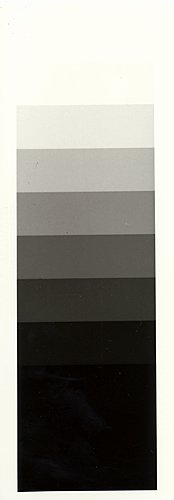brian steinberger
Subscriber
I finally got around to making some test wedges on Ilford warmtone RC paper so I can do some toning experiments. I had a stouffer TP 4x5 21-step tablet that I've had for a while now. I put it in the enlarger to expose it onto a 5x7 piece of paper at around 4x6. After a few tests to get the contrast right, I ended up dialing in grade 00 and the step wedge was still too dense to produce full range of tones.
So what I did was take just one side (the thinner side) of the step wedge and increased contrast to make an 11 step wedge with tones from black to white. I could also rotate the paper after each exposure and get two wedges on one piece of 5x7 paper.
There has to be an easier way to do this. I would like to produce wedges similar to Tim Rudman's in his toning book. I saw stouffer has a nice step wedge that is 1/2" x5" but I would want to enlarge the wedge to make the step wedges bigger on paper.
How has anyone else done this? My way is not bad, I guess, but I would like more steps. See mine here.
So what I did was take just one side (the thinner side) of the step wedge and increased contrast to make an 11 step wedge with tones from black to white. I could also rotate the paper after each exposure and get two wedges on one piece of 5x7 paper.
There has to be an easier way to do this. I would like to produce wedges similar to Tim Rudman's in his toning book. I saw stouffer has a nice step wedge that is 1/2" x5" but I would want to enlarge the wedge to make the step wedges bigger on paper.
How has anyone else done this? My way is not bad, I guess, but I would like more steps. See mine here.













